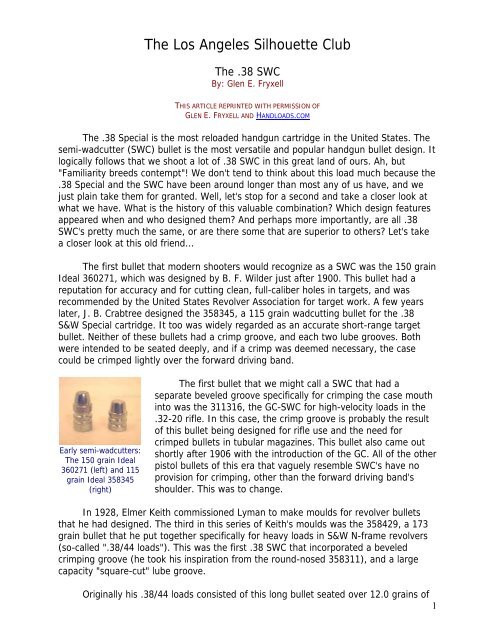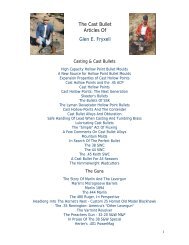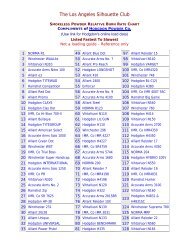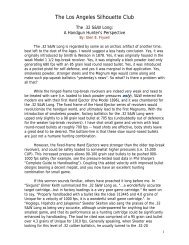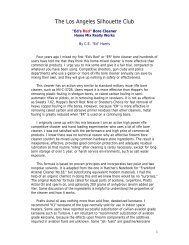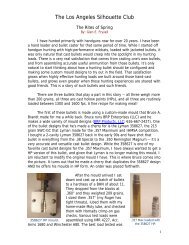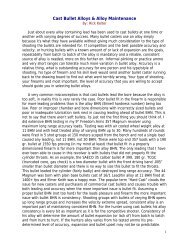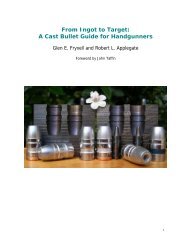Create successful ePaper yourself
Turn your PDF publications into a flip-book with our unique Google optimized e-Paper software.
(Lyman/Ideal 357453, 401452, and 429360) were similar to the Keith SWC's, exceptthat they had rounded grease grooves, the forward driving band was smaller than theback two driving bands, and the ogive was straight instead of radiused. It's notuncommon to hear the uninitiated refer to these Boser bullets as "Keith SWC's" but todo so is to ignore the contributions of both men. The Boser .38 SWC (Lyman/Ideal358453) weighs about 150 grains. The straight ogive SWC was resurrected by Lee inthe 1970s.Jim Harvey brought an interesting twist to the .38 SWC concept in the mid 1950swith this "Harvey Pro-Tex Bore" line of bullets. These bullets were designed withoutlube or crimp grooves and were cast through the hole in a zinc washer, permanentlyimbedding the washer into the bullet.Not having to size and lube these bullets was aselling feature. The hard zinc washer allowed soft leadalloys to be used to promote expansion. Extravagantclaims were made about "the solid lubricating ability ofzinc", and how this lead to unprecedented velocities,etc. Some pretty eye-popping velocities were reported,but top accuracy was generally limited to moderatevelocity loads.Lachmiller was an active player in the bulletmould field in the 1950s, and like most other mouldmakers they had a 158 grain SWC for the .38 Specialand .357 Magnum.The Lyman 358156GC-SWC; probablythe most popularcast bullet ever forthe .357 MagnumThis bullet, perhaps best ofall the moulds discussed here,captures the design features thatA portion of the Cramer catalog(circa 1939); of particular interestare the GC-SWC's #13 and #14(scan taken from the excellentreference resource "CastpicsResearch and Development"http://www.castpics.net/research.htm)Keith and Sharpe promoted -- 3 full-size driving bands, a full-sizeflat-bottomed grease groove, a beveled crimp groove and afunctional ogive/meplat that would work in all guns.This is an excellent bullet and one of my personal favorites.Lachmiller was bought out by RCBS in the late 1970s.Ohaus started making bullet moulds in 1972 and laterthat decade RCBS bought them out and took over mouldproduction. These moulds are well thought-out derivativesof proven designs. In terms of .38 SWC's, RCBS makes 2particularly well designed moulds, the 150 PB SWC and the158 grain GC-SWC.The 150 grain Lyman 358477SWC; a fine bullet for both .38Special and .357 Magnum.The GC 158 is very similar to the 358156 (having asomewhat larger grease groove and lacking the secondcrimp groove), and like the .358156, is a superb all-round .357 Magnum bullet.5
GordonBoser'sSWCdesign.Lee started making bullet moulds in 1973, and not surprisingly, theyalso included various .38 SWC's in their line. The first bullet mould I bought,when I started casting, was a 6-cavity Lee .38 150 SWC. I used that mouldto make a lot of bullets. Lee not only offers PB and GC designs, but alsocame out with their novel tumble-lube (TL) designs. Their affordable 6 cavitymoulds allow a budding young caster on a limited budget to make a pile ofbullets in a hurry, but in general, their lube grooves are too shallow for mytaste.In the late 1980s, a new handgun game had come to national prominence andLyman brought out its 215 grain GC-SWC (#358627) to address the silhouette market.This bullet is basically the Keith SWC with a GC shank added onto the base and an extracrimp groove added up front. While this husky bullet shoots fine in both the .38 Special(800 fps) and the .357 Magnum (1100 fps), it was really designed for the .357Maximum. 1400+ fps is no problem with this heavyweight from a.357 Maximum, making this the hardest hitting member of the .38SWC clan.Bevel bases are popular in cast bullets designed for commercialproduction. This is due to the fact that the BB bullet releases morereadily from the casting machine moulds used by these outfits, andtherefore production rates are higher when using BB moulds (there'sno significant difference for the home caster).Lachmiller 3-cavity 358 158 SWCmould.In addition, the commercialcaster wants to provide a productthat is going to generate the fewestnumber of complaints, and well tobe honest, there are somehandloaders who are a little roughduring load assembly, and if the BBbullet slips into the case moreeasily and with less damage, then those customers aren't going towhine as much.The Lyman 357500Harvey Pro-TexBore SWC mould(the slot at thebase of the bullet iswhere the zincwasher fits into themould prior topouring the moltenalloy into thecavity; the conicalrivet below that iswhat holds thewasher in place).However, in some guns, BB bullets can lead to increased leading in the forcingcone area, as the throat/bullet seal is broken while there is lots of exposed lead in thecylinder gap (this problem is most commonly encountered in guns with a large cylindergap). The bottom line is that, as far as the shooter is concerned, beveled bases on castbullets are kinda like earrings on professional football players, some folks may thinkthey're fashionable, but they provide nothing in terms of actual performance. Therehave been a number of other designs with long noses (e.g. the H&G #73), smallmeplats, or minor variations on these designs. In an effort to sharpen the focus of thisdiscussion, I will draw the line here.The design elements espoused by Keith and Sharpe (full diameter forward drivingband, beveled crimp groove, large grease groove, moderately large meplat andradiused ogive) are just as valuable today as they were back in the 1930s. Which of6
The RCBS 150 SWC, anexcellent bullet for both .38Special and .357 Magnum.these bullets best capture these features ina form most usable in the .38 Special and.357 Magnum cartridges? That is a questionof weight, bearing surface, balance and noselength. All of these bullets have given mefine accuracy when launched from properlyassembled, well-balanced loads. OK, sowhich of these .38 SWC's provide the bestcombination of velocity and accuracy from the .38 Special and the .357Magnum? For somebody who is just starting out and may not have theconnections to find moulds that were made 50+ years ago, what iscurrently available and what would be their best choice? Having fired many, manythousands of these bullets, my votes fall thusly:Best SWC for the .38 Special:Lyman358627SWC loadedin .357Maximum.Putting a GC on .38 Special bullet is kinda like putting a frilly lace dress on JohnWayne -- it just doesn't belong there! As mentioned above, my personal favorite bulletfor the .38 Special is the original 150 grain version of the Lyman 358477. Any numberof good loads will generate 950 fps with this bullet, and do so quite accurately, but myfavorite is 5.4 grains of Unique. As far as what is available today, the RCBS 38 150 SWC(they call it a "Keith" but it's doubtful that Elmer actually designed it) is an excellentmould and gets my vote for the best bullet currently available for the .38 Special. Thelighter weight of these two bullets allows the sixgunner to get optimum performanceout of a .38 Special revolver.Best SWC for the .357 Magnum:The higher pressures and higher velocities of the .357 Magnum make a GC muchmore at home in this cartridge. While GC are by no means required for this level ofballistic performance, they can make a contribution and fit in nicely here. The Lyman358156 is probably the most popular cast bullet of all time for the .357 Magnum, and iscertainly one of my own personal favorites. The very similar RCBS 38 158 GC-SWCserves with equal distinction, it just doesn't have as long, or as colorful, a historybehind it. Both of these bullets are currently available for the new caster just startingout. I also shoot a number of plain-based cast bullets in my .357s, my favorites beingthe H&G #51 (H&G moulds are currently available through Ballisti-Cast), the Lachmillerand Cramer SWC's; excellent .357 bullets all. For all of these bullets, my preferredpowder charge is 14.0 grains of 2400.Best .38 SWC All-round:As an all-round cast bullet for both .38 Special and .357 Magnum, my ownpersonal choice would be for a plain-based bullet of 158-160 grains, with the drivingbands as close to one another in size as possible, with a flat-bottomed grease groove,and a beveled crimp groove. These features are captured in the 160 grain H&G #51,the Lachmiller 38 158 SWC, and the Cramer #12.7
Best All-round. the H&G # 51,the Lachmiller 38-158 SWC, andthe Cramer # 12.All of these bullets perform beautifullyin both the .38 Special and the .357 Magnum.Currently available moulds in this class arethe H&G #51, which is available throughBallisti-Cast, and the SAECO #382 (which, asdiscussed earlier, can trace its heritage to theCramer line). All of these bullets are versatile,accurate and deadly.SAECO #382 150Grain PB.The .38 SWC was born at the dawn of the 20th century. Elmer Keith took some ofthe ideas captured in some of the early target bullets and incorporated a beveledcrimping groove and a larger, "square-cut" grease groove.Phil Sharpe shortened Keith's design to make it function in the original N-frame.357 Magnum. Others, like Ray Thompson and Gordon Boser, added their touch to thisbasic design, massaging it slightly for each successive generation of .38 shooters. As aresult of these men's efforts, the .38 SWC is a refined, versatile and highly useful bulletdesign. If the value of a bullet can be judged based upon the gross tonnage of thatbullet design sent downrange each year, then the .38 SWC is clearly one of the mostvaluable handgun bullets of all time!Warning: All technical data mentioned, especially handloading and bullet casting, reflect thelimited experience of individuals using specific tools, products, equipment and componentsunder specific conditions and circumstances not necessarily reported in the article or on thisweb site and over which The Los Angeles Silhouette Club (<strong>LASC</strong>), this web site or the authorhas no control. The above has no control over the condition of your firearms or your methods,components, tools, techniques or circumstances and disclaims all and any responsibility for anyperson using any data mentioned. Always consult recognized reloading manuals.The <strong>LASC</strong> <strong>Front</strong> <strong>Page</strong>Index to all <strong>LASC</strong> ArticlesGlen E. Fryxell Article Index8


